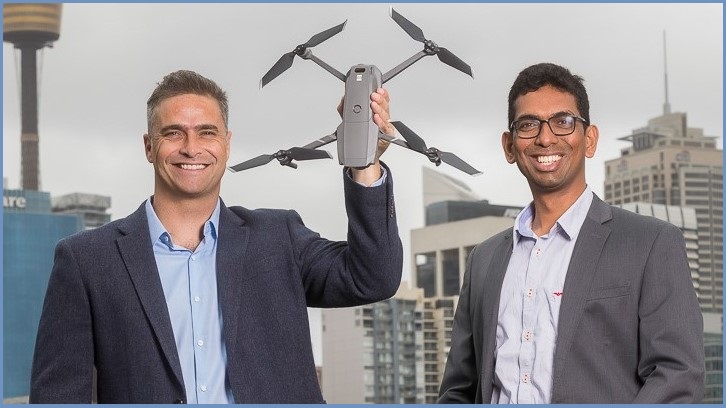Qantas pilot Tom Caska was living the dream, flying across the globe – until a water sport accident shattered his career.
In 2014, the then 30-year-old suffered a broken neck and spinal cord damage, while kite surfing in Cairns, Queensland.
Recovery from his injuries would take 18 months.
Picking up the pieces and starting over, Caska flew to South Africa to volunteer his knowledge in aerial and drone technology with the South African anti-poaching unit.
The objective was to use drones to spot rhinos, then move them to safety away from poachers.
Volunteer work helped cement his pursuit in pushing further ahead with drone technology.
In 2019, Caska returned to Sydney to complete his MBA at AGSM where he met fellow student, Rakesh Routhu.
The pair combined their business experience.
Caska's previous drone photography business, Aerolens, and Routhu's drone swarm management, R2 Robotronics combined to create Aerologix, the "Uber for drones", a platform that connects drone pilots with enterprises or individuals that require drone imaging.
To get their idea up and running, the two travelled to Silicon Valley USA in early 2020 to fund their business.
“The venture capitalists in Silicon Valley were great, we got positive feedback – we even discussed setting up the company in the USA – then COVID hit and the pitches stopped and everything shut down, including the cheque books!” says Caska.
The duo returned to Australia where they found pitching was just as challenging.
“Back home we saw multiple investors and they halved our valuation down – it felt like we were in the midst of a power-play. Aussie investors are way more risk-adverse, especially during COVID,” says Caska.
‘When you’re a founder trying to get backing and then throw COVID in the mix, you’re between a rock and a hard place. It looks very attractive to give up half of your company to an investor to get the backing.”
Thankfully, the pair were given a lifeline when they received a $25,000 grant from NSW government MVP (minimum viable product ) grant and $20,000 from the UNSW Founders 10x accelerator program.
“I remember having discussions with investors six month prior to COVID, and then having the same conversation again. They said just halve everything and expect to give up more,” says Caska.
In September 2021, funds also came from investors Nightingale Partners who invested $1.5 million into their business.
For anyone looking for investors, the pair say: don’t be sold short, back yourself and hold off if needed, and apply for government grants.
Today, Aerologix runs a full web interface, similar to Uber, where clients and customers can order on-demand drone vision, anywhere, anytime, across the country.

“We call it drone vision; think of it as data, from a satellite network. We can create reports and interpret all sorts of information from the data captured by the drone,” says Caska.
Much like Uber drivers, pilots are signed up and trained by Aerologix and their training partners.
Once the pilots have completed their training, they become a live asset on the drone pilot network where they can pick up different types of projects.
“We have built a system where our drone pilot can receive a project and when they turn up to the site our software takes over their drone and fly the project for them; they receive a very high, quality output every time, this eliminates user error,” Caska adds.
Aerologix has 900 pilots on its network, including some large corporate clients including a recently added multi-national telecommunication company.
Staff has grown to 20 across Australia and their other base in India.
“This has been supercharged due to COVID as we can scale across the country with everyone online and timelines reduced,” Caska says.
For example, where there has been storms and roofs have been damaged, drones are sent out to do the assessments.
“Drones are a good choice to go out and do the assessment. Along with providing reports of the damage, this can go straight to the claims or assessment companies and it speeds up the whole process.”
As for the future, scaling the business and perfecting the technology is top of mind.
‘Drone tech will become commonplace in society,” says Routhu.
“We will see drones flying across our city, taking information quickly, delivering emergency services, medical packages, and facilitated by 5G.”
The pair’s vision for Aerologix is for it to be the mission hub for drone control and data.
“In the future, there will be dedicated drone corridors, or airspace, and we want to provide ‘drones in a box’ placed in strategic locations, such as building tops, and then using a common control system to tell the drone what to do – much like a sprinkler system activates from a central control,” adds Routhu.
Finally, they will use their technology to help the community.
“We can provide this by giving free access to systems for first respondents and the like, to do search and rescue,” Caska says.










